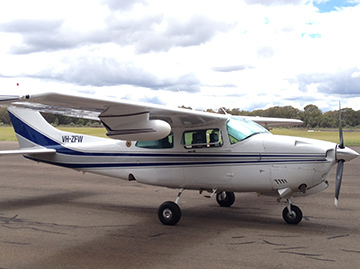- Oil on the windscreen due to an unsecured engine oil filler cap prompted the pilot of a Cessna T210N to attempt a go-around, with tragic results.

On 4 July 2014, the owner/pilot of a Cessna aircraft and two passengers were conducting a private flight from Inverell Airport to Bankstown Airport, New South Wales.
Shortly after take-off, oil appeared on the windscreen and the pilot rejected the take-off with the intent of landing back on the runway.
With the oil obscuring the pilot’s forward vision, the pilot looked to the left of the aircraft to assess their position along the runway. The pilot realised they were a lot further along the runway than expected and had insufficient runway distance to land safely. The pilot attempted a go-around but later reported the engine did not respond. During the subsequent forced landing, the aircraft impacted a shrub beyond the end of the runway overrun and flipped, before coming to rest inverted.
The pilot and a passenger were hospitalised with serious injuries and the second passenger received minor injuries. Tragically, the seriously-injured passenger later succumbed to their injuries. The aircraft was destroyed by the impact forces and a post-impact fuel-fed fire.
Examination of the aircraft found the engine oil filler cap detached from the oil filler tube but hanging by its chain. Further examination of the tube and cap determined that it was most likely the cap was not secure before the flight commenced.
The Cessna T210N pilot’s operating handbook advised pilots to check the engine oil level during a pre‑flight inspection but not the security of the separate oil filler cap. The ATSB could not establish the extent to which a specific checklist item about oil filler cap security would have assisted in identifying the unsecured cap in this case, although it would probably have increased the likelihood of detection.
Witness observations and the pilot’s assessment of the aircraft’s position along the runway during the rejected take-off indicated that the take-off was longer than normal. The reason for this could not be determined.
Examination of the engine and turbocharger found no mechanical defect or failure that would have precluded normal operation. While it was possible that a temporary issue occurred, resulting in the reported lack of engine response during the go-around, this could not be established.
The ATSB also determined that the engine manufacturer’s oil change interval had been exceeded by 3 months but it was very unlikely that this had any effect on the operation of the engine.
Safety message
This accident highlights that, prior to take-off, pilots should have in mind a go/no-go decision point along the runway by which time the aircraft should become airborne. If at that point the aircraft is not airborne, the pilot should reject the take-off. Having such a point assists pilot decision making during a critical phase of flight. This is particularly important when operating in conditions that may affect aircraft performance, such as tailwind conditions.
In addition, the ATSB highlights the importance of being aware of the daily inspection requirements when operating aircraft under a CASA maintenance schedule. In particular, how this may differ from the aircraft manufacturer’s pre-flight inspection procedure.
Read the report: Collision with terrain involving Cessna T210N, VH-ZFW, near Inverell Airport, New South Wales, on 4 July 2014


